spare tire CHEVROLET BLAZER 1998 2.G Owners Manual
[x] Cancel search | Manufacturer: CHEVROLET, Model Year: 1998, Model line: BLAZER, Model: CHEVROLET BLAZER 1998 2.GPages: 416, PDF Size: 22.4 MB
Page 25 of 416
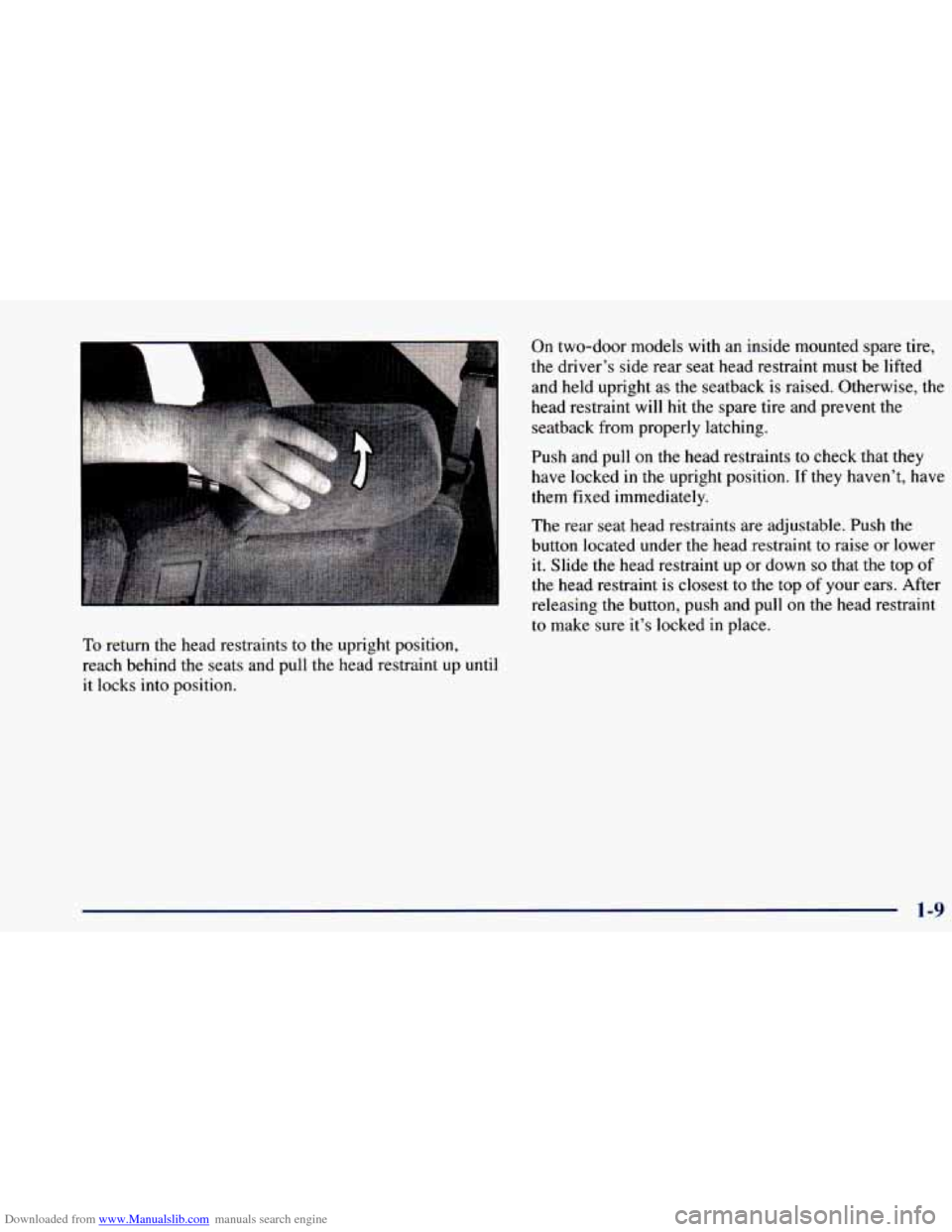
Downloaded from www.Manualslib.com manuals search engine To return the head restraints to the upright position,
reach behind the seats and pull the head restraint up
until
it locks into position.
On two-door models with an inside mounted spare tire,
the driver’s side rear seat head restraint must be lifted
and held upright as the seatback is raised. Otherwise, the
head restraint will hit the spare tire and prevent the
seatback from properly latching.
Push and pull on the head restraints to check that they
have locked in the upright position. If they haven’t, have
them fixed immediately.
The rear seat head restraints are adjustable. Push the
button located under the head restraint to raise or lower
it. Slide the head restraint up or down
so that the top of
the head restraint is closest to the top of your ears. After
releasing the button, push and pull
on the head restraint
to make sure it’s locked in place.
Page 77 of 416
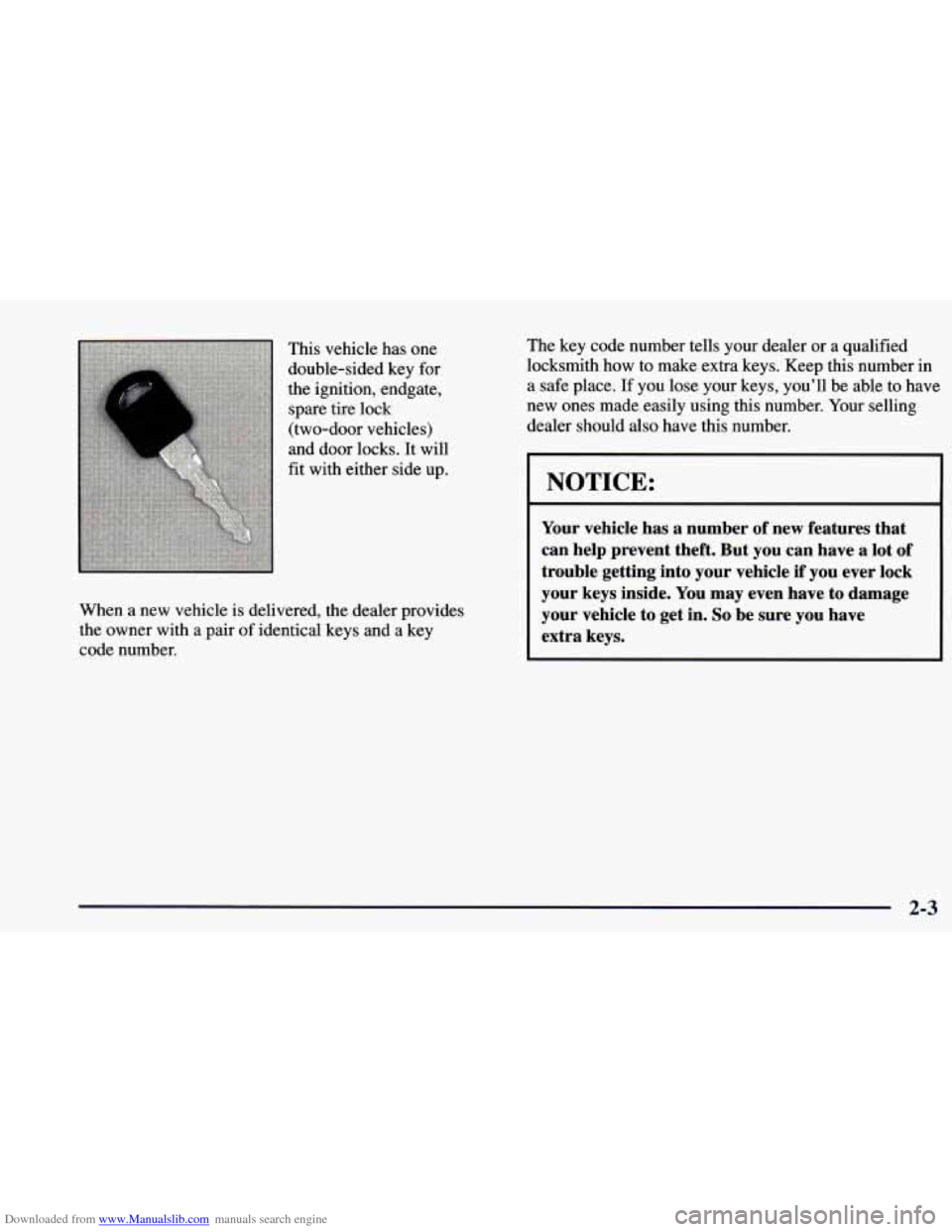
Downloaded from www.Manualslib.com manuals search engine This vehicle has one
double-sided key for
the ignition, endgate,
spare tire lock
(two-door vehicles)
and door locks. It
will
fit with either side up.
When a new vehicle is delivered, the dealer provides
the owner with a pair of identical keys and a key
code number. The
key code number tells your dealer or a qualified
locksmith how to make extra keys. Keep
this number in
a
safe place. If you lose your keys, you’ll be able to have
new ones made easily using this number. Your selling
dealer should
also have this number.
I NOTICE:
Your vehicle has a number of new features that
can help prevent theft. But you can have a lot of
trouble getting into your vehicle if you ever lock
your keys inside. You may even have to damage
your vehicle to get in.
So be sure you have
extra keys.
- - -
2-3
Page 83 of 416
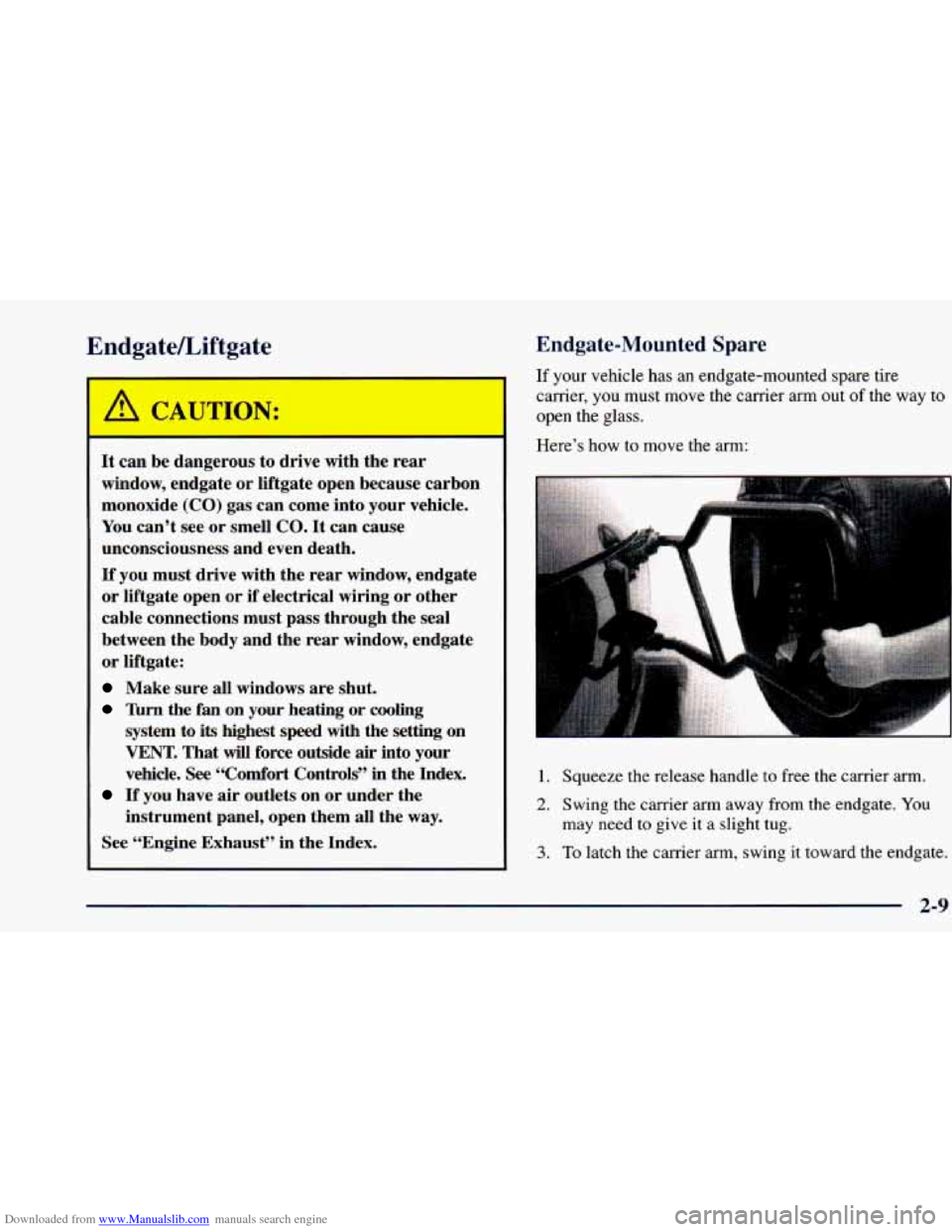
Downloaded from www.Manualslib.com manuals search engine EndgateLiftgate
It can be dangerous to drive with the rear
window, endgate or liftgate open because carbon
monoxide
(CO) gas can come into your vehicle.
You can’t see or smell
CO. It can cause
unconsciousness and even death.
If you must drive with the rear window, endgate
or liftgate open or
if electrical wiring or other
cable connections must pass through the seal
between the body and the
rear window, endgate
or liftgate:
Make sure all windows are shut.
lhrn the fan on your heating or cooling
system to its highest speed with the setting on
VENT. That will force outside air into your
vehicle. See
64C~~0~ Controls’’ in the Index.
instrument panel, open them all the way.
If you have air outlets on or under the
See “Engine Exhaust” in the Index.
Endgate-Mounted Spare
If your vehicle has an endgate-mounted spare tire
carrier, you must move the carrier arm out
of the way to
open the glass.
Here’s how to move the arm:
1. Squeeze the release handle to free the carrier arm.
2. Swing the carrier arm away from the endgate. You
may need to give it a slight tug.
3. To latch the carrier arm, swing it toward the endgate.
2-9
Page 197 of 416
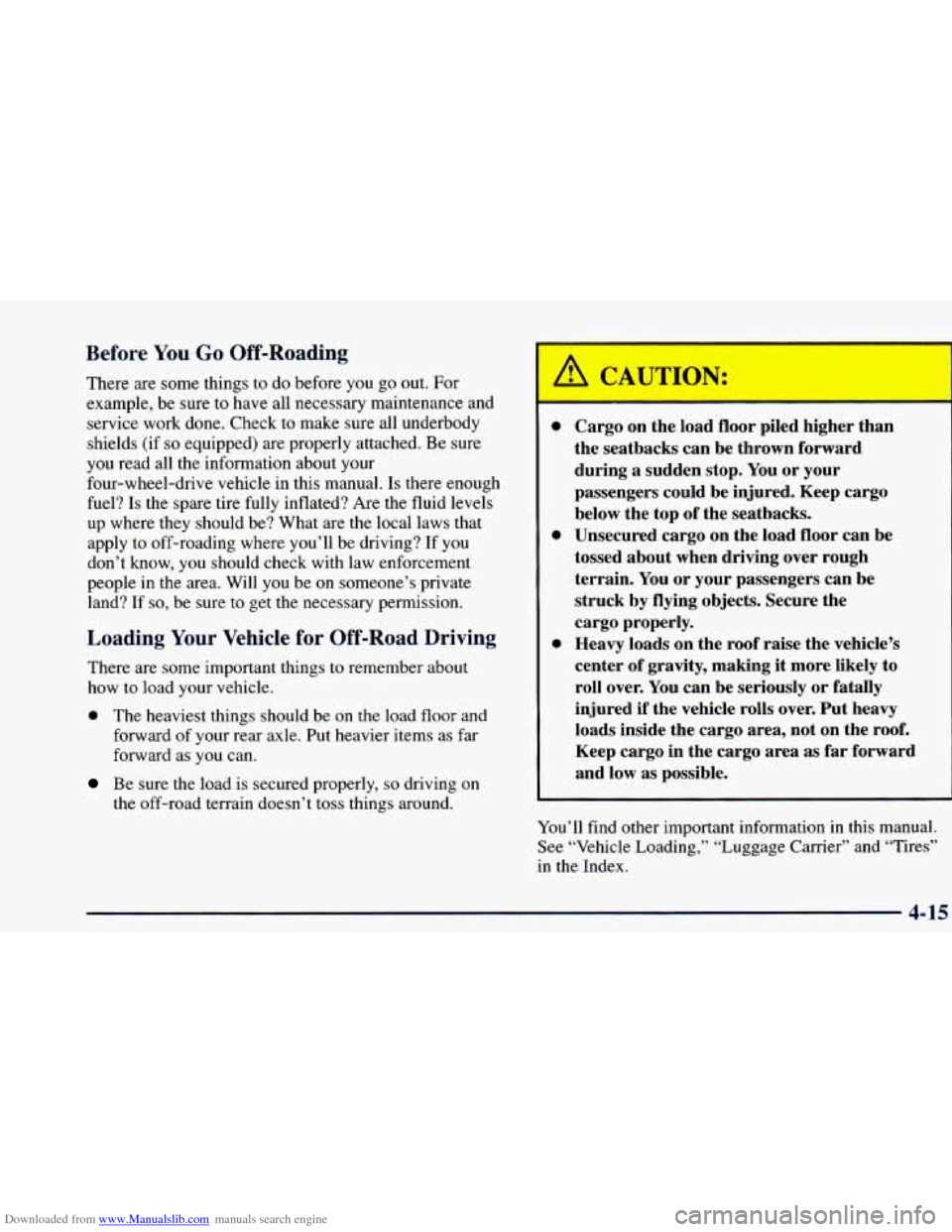
Downloaded from www.Manualslib.com manuals search engine Befi: - 1 ~ u Go Off-Roading
There are some things to do before you go out. For
example, be sure to have all necessary maintenance and
service work done. Check to make sure all underbody
shields (if
so equipped) are properly attached. Be sure
you read all the information about your
four-wheel-drive vehicle
in this manual. Is there enough
fuel?
Is the spare tire fully inflated? Are the fluid levels
up where they should be? What are the local laws that
apply to off-roading where you’ll be driving? If you
don’t know, you should check with
law enforcement
people in the area. Will you be on someone’s private
land? If
so, be sure to get the necessary permission.
Loading Your Vehicle for Off-Road Driving
There are some important things to remember about
how to load your vehicle.
0 The heaviest things should be on the load floor and
1
forward of your rear axle. Put heavier items as far
forward
as you can.
Be sure the load is secured properly, so driving on
the off-road terrain doesn’t toss things around.
CAUTION:
0
0
0
Cargo on the load floor piled higher than
the seatbacks can be thrown forward
during
a sudden stop. You or your
passengers could be injured. Keep cargo
below the top of the seatbacks.
Unsecured cargo on the load floor can be
tossed about when driving over rough
terrain. You or your passengers can be
struck by flying objects. Secure the
cargo properly.
Heavy loads on the roof raise the vehicle’s
center of gravity, making it more likely to
roll over. You can be seriously or fatally
injured
if the vehicle rolls over. Put heavy
loads inside the cargo area, not on the roof.
Keep cargo in the cargo area as
far forward
and low as possible.
You’ll find other important information
in this manual.
See “Vehicle Loading,” “Luggage Carrier” and “Tires”
in the Index.
4-15
Page 233 of 416
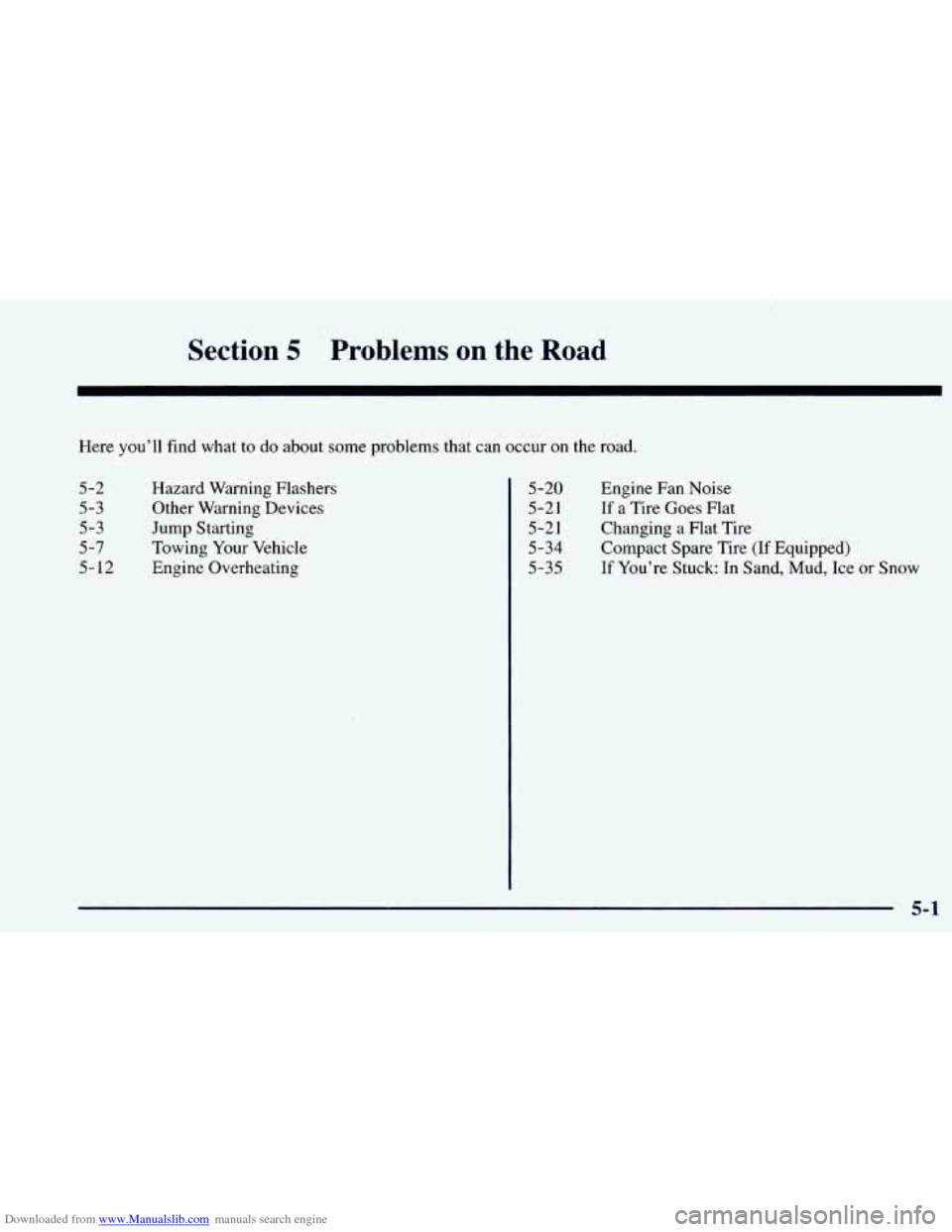
Downloaded from www.Manualslib.com manuals search engine Section 5 Problems on the Road
Here you’ll find what to do about some problems that can occur on the road.
5-2
5-3
5-3
5 -7
5- 12 Hazard Warning
Flashers
Other Warning Devices
Jump Starting
Towing Your Vehicle
Engine Overheating
5 -20
5-2 1
5-2 1
5-34
5-35
Engine Fan Noise
If
a Tire Goes Flat
Changing a Flat Tire
Compact Spare Tire
(If Equipped)
If You’re Stuck:
In Sand, Mud, Ice or Snow
5-1
Page 254 of 416
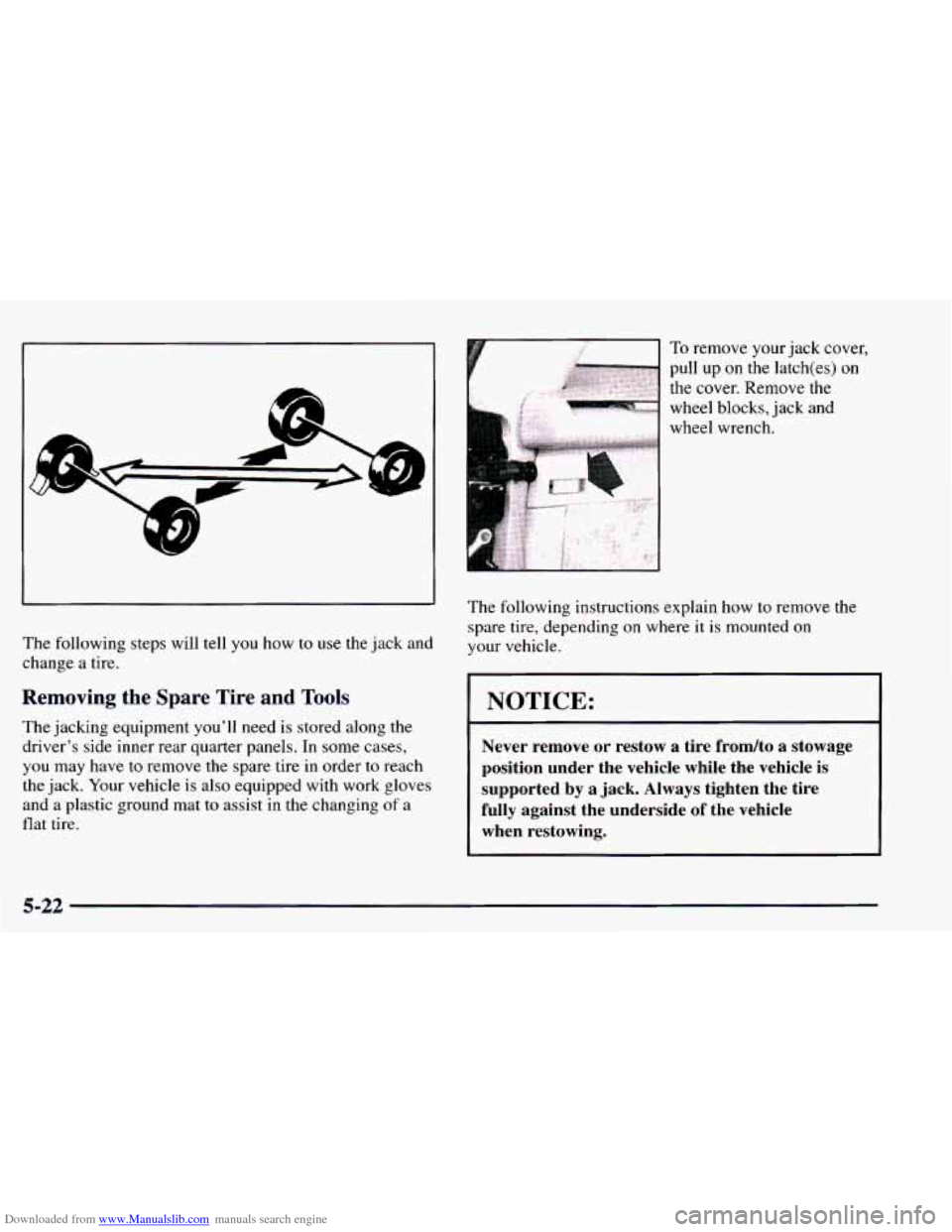
Downloaded from www.Manualslib.com manuals search engine The following steps will tell you how to use the jack and
change a tire.
Removing the Spare Tire and Tools
The jacking equipment you’ll need is stored along the
driver’s side inner rear quarter panels.
In some cases,
you may have to remove the spare tire in order to reach
the jack. Your vehicle is
also equipped with work gloves
and a plastic ground mat
to assist in the changing of a
flat tire. The following instructions explain how
to remove the
spare tire, depending on where
it is mounted on
your vehicle.
I NOTICE:
Never remove or restow a tire frondto a stowage
position under the vehicle while the vehicle is supported
by a jack. Always tighten the tire
fully against the underside of the vehicle
when restowing.
5-22
Page 255 of 416
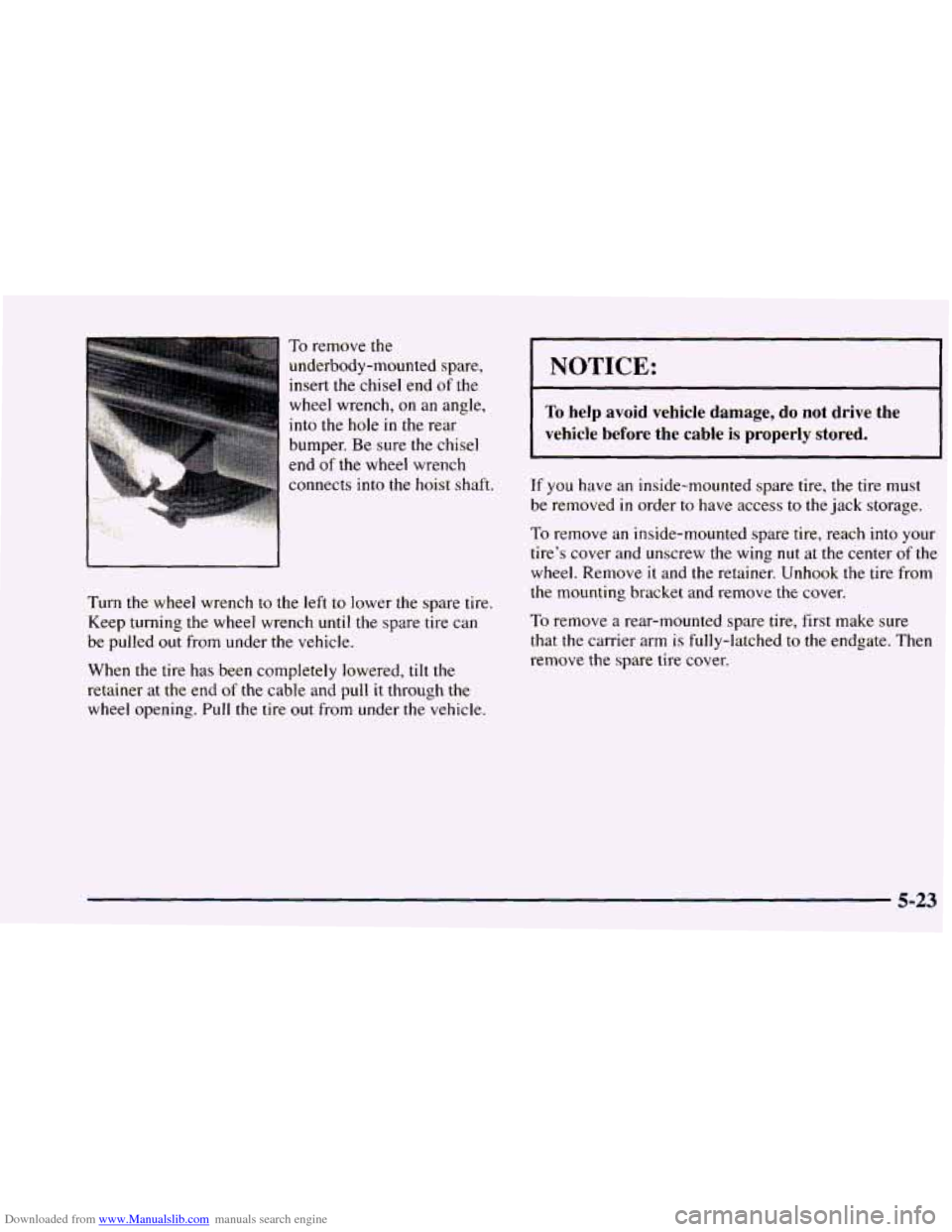
Downloaded from www.Manualslib.com manuals search engine To remove the
underbody-mounted spare,
insert the chisel end of the
wheel wrench,
on an angle,
into the hole
in the rear
bumper. Be sure the chisel
end
of the wheel wrench
connects into the hoist shaft.
Turn the wheel wrench to the left to lower the spare tire.
Keep turning the wheel wrench until the spare tire can
be pulled
out from under the vehicle.
When the tire
has been completely lowered, tilt the
retainer
at the end of the cable and pull it through the
wheel opening.
Pull the tire out from under the vehicle.
I NOTICE:
- ~~
To help avoid vehicle damage, do not drive the
vehicle before the cable
is properly stored.
If you have an inside-mounted spare tire, the tire must
be removed
in order to have access to the jack storage.
10 remove an inside-mounted spare tire, reach into your
tire’s cover and unscrew the wing nut at the center
of the
wheel. Remove
it and the retainer. Unhook the tire from
the mounting bracket and remove the cover.
To remove a rear-mounted spare tire, first make sure
that the carrier arm is fully-latched
to the endgate. Then
remove the spare tire cover.
5-23
Page 256 of 416
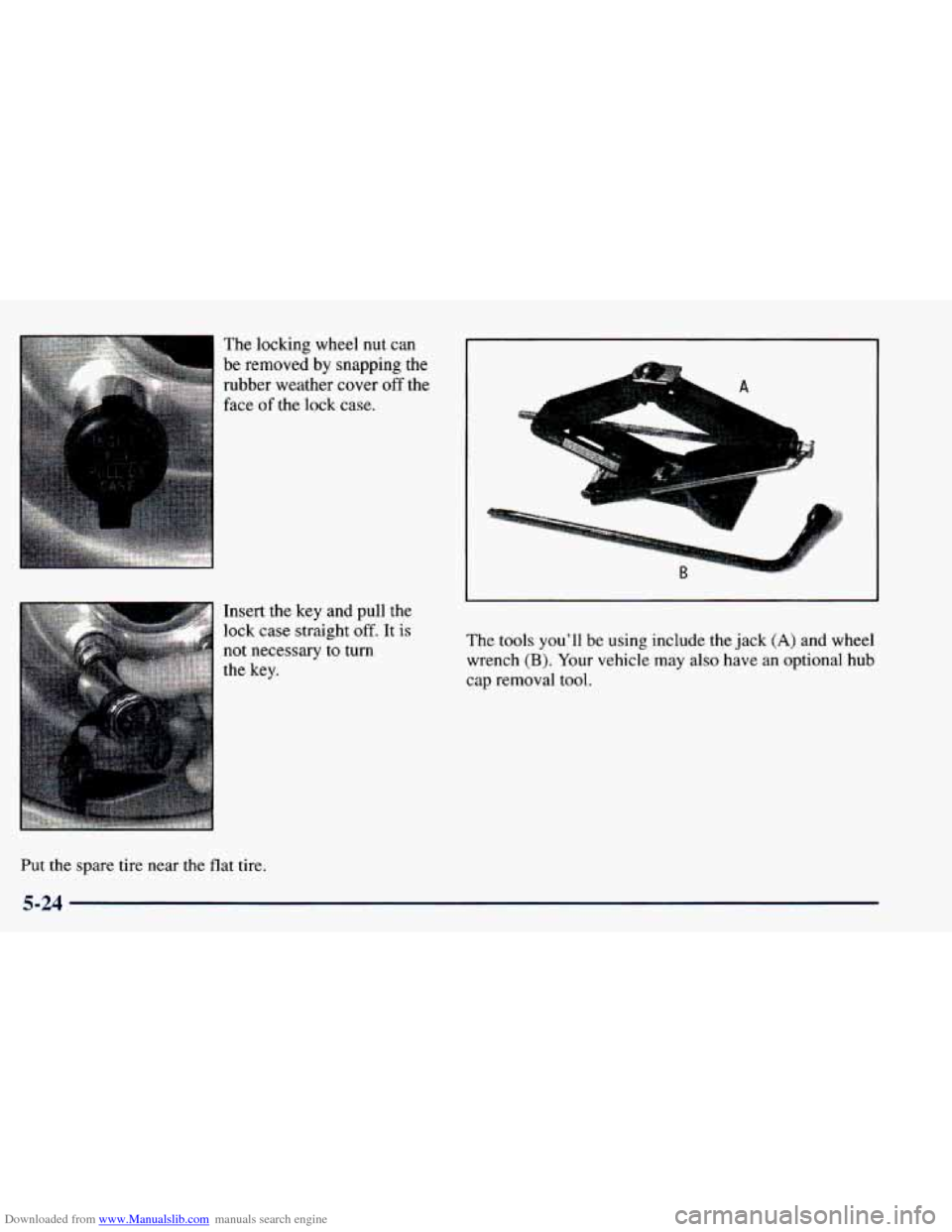
Downloaded from www.Manualslib.com manuals search engine The locking wheel nut can
be removed by snapping
the
rubber weather cover off the
' face of the lock case.
Insert the key and pull the
lock case straight off. It is
not necessary to turn
the key. The
tools you'll be using include the jack (A) and wheel
wrench
(B). Your vehicle may also have an optional hub
cap removal tool.
Put
the spare tire near the flat tire.
5-24
Page 258 of 416
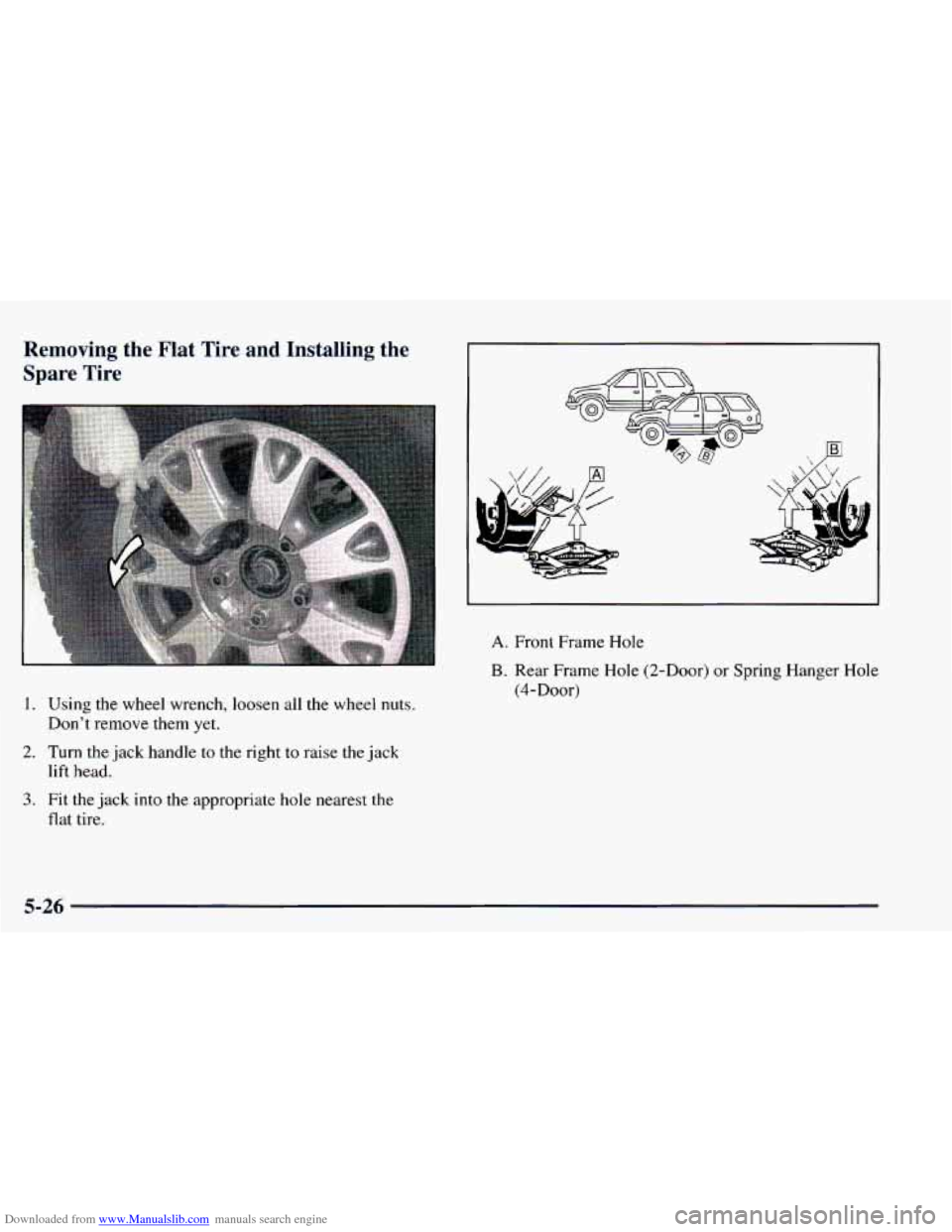
Downloaded from www.Manualslib.com manuals search engine Removing the Flat Tire and Installing the
Spare Tire
1. Using the wheel wrench, loosen all the wheel nuts.
Don’t remove them yet.
2.
Turn the jack handle to the right to raise the jack
lift head.
3. Fit the jack into the appropriate hole nearest the
flat tire.
A. Front Frame Hole
B. Rear Frame Hole (2-Door) or Spring Hanger Hole
(4-Door)
5-26
Page 259 of 416
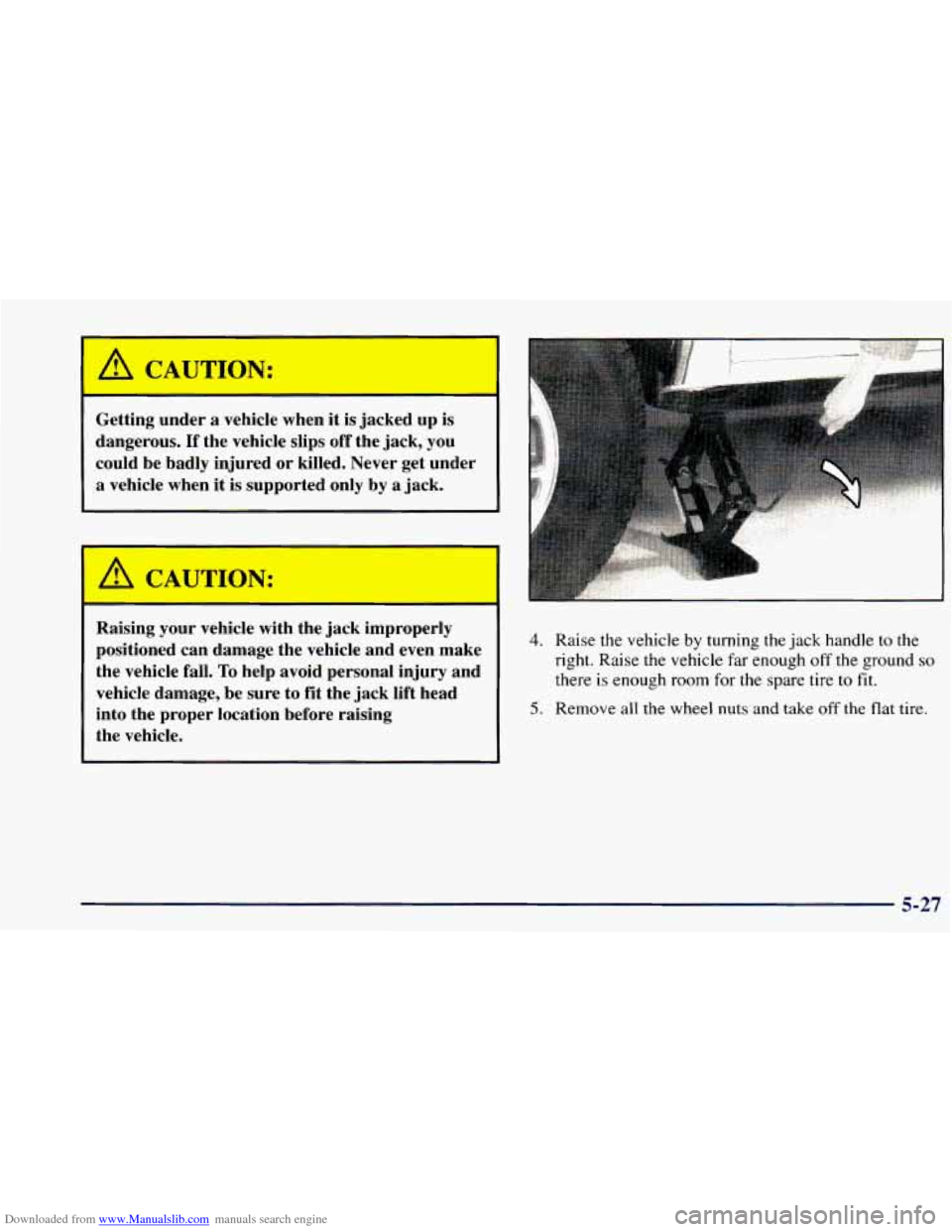
Downloaded from www.Manualslib.com manuals search engine Getting under a vehicle when it is jacked up is
dangerous.
If the vehicle slips off the jack, you
could be badly injured
or killed. Never get under
a vehicle when it is supported only by a jack.
r-
Raising your vehicle with the jack improperly
positioned can damage the vehicle and even make
the vehicle fall.
To help avoid personal injury and
vehicle damage, be sure to fit the jack lift head
into the proper location before raising
l the vehicle.
4. Raise the vehicle by turning the jack handle to the
right. Raise the vehicle far enough
off the ground so
there is enough room for the spare tire to fit.
5. Remove all the wheel nuts and take off the flat tire.
5-27